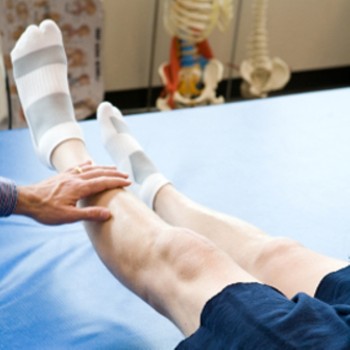
Stretching
They also increase your chances of long-term satisfaction with your artificial knee. It is important to commit to a rehab plan and work with your surgeon and physical therapist to continuously set goals.
Jamie Nelson, PT, DPT, at UCSF, offers insights into exercises that can help you rehab quickly and effectively. Your goal should be to increase from 10 repetitions the first week to 15 in week two and 20 in week three and beyond.
1. STRAIGHT LEG LIFTS

1
This exercise helps strengthen the quadriceps muscle in your thigh and improves the stability of your knee joint. The stronger your quads the more control you will have over your artificial knee.
Lie on your back with your legs fully extended. Lift your leg about six inches and hold for 10 seconds.
2. ANKLE PUMPS

2
While lying flat on your back, bend both ankles up and point your toes toward you. Then bend your ankles down and point your toes away fromyou. As you do this, rotate your foot clockwise and then counterclockwise, keeping your toes pointed toward the ceiling.
This exercise helps to circulate blood back to the heart in order to reduce swelling and reduce the risk of developing a DVT (deep vein thrombosis–a blood clot that can be dangerous).
3. THIGH SQUEEZES

3
Lie flat on your back and tighten the muscles in front of your thigh by pushing the back of your knee down toward the floor. Hold for five seconds and relax.
This exercise helps reduce swelling in the knee and builds distal quadriceps strength. This is crucial for standing with your knee locked and for walking.
4. LEG SLIDES

4
Lie on your back and slide your leg out to the side while your kneecap is pointed upward. Then slide your leg back to the starting position.
This exercise helps activate your abductors, and more specifically your gluteus medius muscle. These muscles are crucial for pelvic stability during the stance phase while walking.
5. KNEE BENDING

5
Sit in a stable chair and bend your leg so that it is underneath the seat, bending your knee back as far as possible. Hold it for five seconds and then return it to the resting position.
This exercise can help to improve your range of motion.
6. PROLONGED KNEE STRETCH

6
Sit in a chair, bend your knee back as far as possible, and hold for 15-30 seconds. As you gain range of motion, scoot forward in the chair to increase the stretch. Over time and as tolerated, increase the duration of the stretch to 60 seconds and repeat several times per day.
This exercise focuses on increasing knee flexion (range of motion). This is crucial for higher level activities like getting out of a low chair, going up a flight of stairs and driving.
7. HEEL SLIDES

7
Lie flat on your back and then bend your hip and knee by sliding your foot and heel upward toward your buttocks. Then slide your foot and heel back to the starting position. Keep your kneecap pointed toward the ceiling during the entire exercise.
This exercise focuses on building hamstring strength as well as improving active knee flexion range of motion. Both are important for all activities of daily living.
8. LYING KICKS

8
This exercise helps build the quadriceps muscle through a larger range of motion.
Lie on your back on the floor or a bed and place a rolled blanket or large coffee can under your knee. Straighten your lower leg and hold the position for 5 seconds. Slowly lower your leg and rest. Make sure the back of your knee stays in contact with the object the entire time and that the small of your back is on the floor.
9. PASSIVE HAMSTRING STRETCH

9
This exercise is one of the most important exercises to do early in your rehab program. It allows you to start gaining full knee extension which is crucial for gait.
Lie on your back with your leg fully extended. Place your foot on a stack of pillows, allowing your leg (the one with your new artificial knee) to hang freely. Staying in this position, allow your knee to gently stretch for 10 minutes.
10. KNEE STRAIGHTENING STRETCH

10
This exercise also helps increase terminal knee extension range of motion. You can increase the knee extension time to up to 30 minutes.
Sit upright in a chair and place the leg with the artificial knee as straight as possible on an opposite facing chair (opposite chair not shown). Keep the leg extended and straight for 10 minutes; your toes can remain relaxed. Slowly take your leg out of this position as it will be a little sore. Let it rest but keep it moving. After this stretch, it’s a good time to do your heel slides.
For similar stories, click on Stretching.